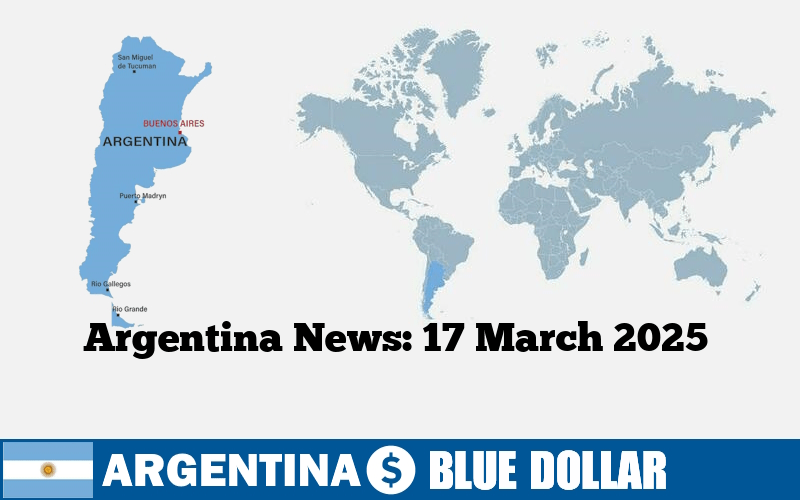Buenos Aires, March 17, 2025 — Argentina’s financial markets experienced a series of noteworthy developments yesterday, reflecting both the challenges and strides within the nation’s economy. From currency fluctuations to fiscal achievements, here’s a comprehensive overview of the day’s key financial events.
Peso Under Pressure Amid Central Bank Interventions
The Argentine peso faced renewed depreciation pressures in the wholesale market, prompting continuous interventions by the Central Bank (BCRA). On Friday, the BCRA sold $474 million to curb the escalating demand for foreign currency, marking one of the most significant interventions under President Javier Milei’s administration. Despite this substantial outflow, the BCRA has managed to accumulate over $3 billion in reserves this year, indicating that the recent sale may not signify a long-term trend. In other market segments, the peso experienced slight declines against the dollar. Market participants are also closely monitoring upcoming economic indicators and legislative discussions concerning a decree related to an agreement with the International Monetary Fund (IMF).
Fiscal Surplus Signals Austerity’s Impact
In February, Argentina reported a primary fiscal surplus of 1.18 trillion pesos (approximately $1.108 billion) and a financial surplus of 310.726 billion pesos. This primary surplus represents about 0.5% of the Gross Domestic Product (GDP), while the financial surplus accounts for nearly 0.1%. The Ministry of Economy highlighted that interest payments totaled 866.189 billion pesos, with 70% directed to the IMF. President Milei has steadfastly committed to maintaining a “zero deficit” policy, vowing to veto any legislation that threatens fiscal balance. Economy Minister Luis Caputo emphasized that these results underscore the administration’s dedication to fiscal discipline, which is essential for a robust and sustainable economy. Notably, in 2024, Argentina achieved its first annual financial surplus in 14 years, reflecting the tangible outcomes of stringent austerity measures.
Anticipated GDP Growth After Prolonged Contraction
After six consecutive quarters of economic contraction, Argentina’s economy is poised for a turnaround. A recent central bank survey of analysts forecasts a 4.8% economic growth for 2025. The national statistics agency is scheduled to release official GDP data for the fourth quarter on Wednesday, with expectations of positive growth signaling a potential end to the prolonged recession.
Market Reactions and Investor Sentiment
The S&P Merval, Argentina’s benchmark stock index, registered modest gains, reflecting cautious optimism among investors. Sovereign bonds also experienced slight upticks, indicating a measured positive response to the government’s fiscal policies. Analysts from Capital Economics noted that while progress toward a new agreement with the IMF is encouraging, it is unlikely that the government will swiftly relax capital controls, especially with upcoming midterm elections on the horizon.
Corporate Movements: Petronas Considers Exit
In the corporate sector, Malaysian oil giant Petronas is reportedly exploring an exit from Argentina. The company had previously withdrawn from a Liquefied Natural Gas (LNG) project and is now contemplating divesting its stake in the Vaca Muerta shale oil field. This potential move underscores the challenges faced by international corporations operating in Argentina’s evolving energy landscape.
Public Discontent Amid Austerity Measures
Social tensions have escalated as austerity measures continue to impact the populace. A recent protest by pensioners demanding higher pensions and the reinstatement of certain free medications turned violent. Riot police employed teargas, rubber bullets, and water cannons to disperse demonstrators, resulting in numerous injuries and leaving a photographer in a coma. The incident has intensified scrutiny of the government’s fiscal policies and their social ramifications.
Consumer Prices Stir Concerns
Inflationary pressures remain a pressing concern for consumers. A viral video by a Spanish tourist highlighted the steep prices of everyday items in Buenos Aires, such as a Milka chocolate bar priced at over 7,000 pesos (nearly 7 euros). This anecdote sheds light on the broader issue of high consumer prices, which continue to strain household budgets.
Today’s Blue Dollar Rate
As of March 18, 2025, the informal or “blue” dollar rate in Argentina stands at 1,245 pesos for buying and 1,265 pesos for selling, reflecting a 0.80% increase from the previous trading session. The blue dollar rate, which operates outside official channels, often serves as a barometer of public confidence in the peso and the broader economy.
Note: All financial figures are based on the latest available data as of March 17, 2025.

